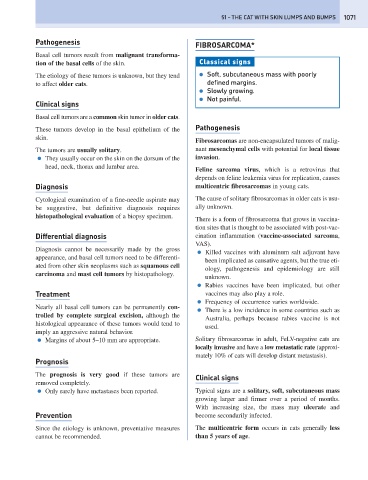Page 1079 - Problem-Based Feline Medicine
P. 1079
51 – THE CAT WITH SKIN LUMPS AND BUMPS 1071
Pathogenesis FIBROSARCOMA*
Basal cell tumors result from malignant transforma-
tion of the basal cells of the skin. Classical signs
The etiology of these tumors is unknown, but they tend ● Soft, subcutaneous mass with poorly
to affect older cats. defined margins.
● Slowly growing.
● Not painful.
Clinical signs
Basal cell tumors are a common skin tumor in older cats.
These tumors develop in the basal epithelium of the Pathogenesis
skin.
Fibrosarcomas are non-encapsulated tumors of malig-
The tumors are usually solitary. nant mesenchymal cells with potential for local tissue
● They usually occur on the skin on the dorsum of the invasion.
head, neck, thorax and lumbar area.
Feline sarcoma virus, which is a retrovirus that
depends on feline leukemia virus for replication, causes
Diagnosis multicentric fibrosarcomas in young cats.
Cytological examination of a fine-needle aspirate may The cause of solitary fibrosarcomas in older cats is usu-
be suggestive, but definitive diagnosis requires ally unknown.
histopathological evaluation of a biopsy specimen.
There is a form of fibrosarcoma that grows in vaccina-
tion sites that is thought to be associated with post-vac-
Differential diagnosis cination inflammation (vaccine-associated sarcoma,
VAS).
Diagnosis cannot be necessarily made by the gross
● Killed vaccines with aluminum salt adjuvant have
appearance, and basal cell tumors need to be differenti-
been implicated as causative agents, but the true eti-
ated from other skin neoplasms such as squamous cell
ology, pathogenesis and epidemiology are still
carcinoma and mast cell tumors by histopathology.
unknown.
● Rabies vaccines have been implicated, but other
Treatment vaccines may also play a role.
● Frequency of occurrence varies worldwide.
Nearly all basal cell tumors can be permanently con-
● There is a low incidence in some countries such as
trolled by complete surgical excision, although the
Australia, perhaps because rabies vaccine is not
histological appearance of these tumors would tend to
used.
imply an aggressive natural behavior.
● Margins of about 5–10 mm are appropriate. Solitary fibrosarcomas in adult, FeLV-negative cats are
locally invasive and have a low metastatic rate (approxi-
mately 10% of cats will develop distant metastasis).
Prognosis
The prognosis is very good if these tumors are Clinical signs
removed completely.
● Only rarely have metastases been reported. Typical signs are a solitary, soft, subcutaneous mass
growing larger and firmer over a period of months.
With increasing size, the mass may ulcerate and
Prevention become secondarily infected.
Since the etiology is unknown, preventative measures The multicentric form occurs in cats generally less
cannot be recommended. than 5 years of age.

